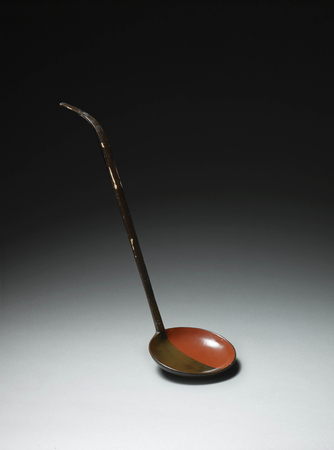Product Description
7727 A Negoro lacquer shakushi (ladle) with black and red katami-gawari design
Japan 17th century Edo period
Dimensions: H. 38cm x W. 10.3cm x D. 18cm (15″ x 4¼” x7¼”)
Exhibited: Negoro: Efflorescence of Medieval Japanese Lacquer Ware, Miho Museum, Shiga prefecture, 1 September – 15 December 2013
Published: Miho museum ed., Negoro: Efflorescence of Medieval Japanese Lacquer Ware, (Tokyo, 2013), p.260, pl.298
Provenance: Todoroki Takashi collection, Tokyo
The main characteristic of Negoro lacquer is its simplicity which exemplifies one aspect of Japanese aesthetics. The robust wood base is durable and practical, and is first coated with black lacquer and then with red or vermilion. Over time and constant use the red lacquer wears away to reveal the black ground beneath, producing the elegant surface characteristic of Negoro. Such rubbing, cracks and chips on Negoro from use and age, something usually regarded as imperfection in other parts of the world, have been admired and appreciated in Japan for centuries. Practical, durable and with sophisticated simplicity, Negoro lacquerware has been favoured by temples and shrines as well as aristocrats, before being sought after by tea masters from the 17th century.
Negoro lacquer is traditionally associated with the Negoro-ji Temple complex in Wakayama prefecture which was founded in the 12th century by monks of the Shingon Buddhist sect. Originally Negoro lacquerware was produced in the studios in and around the temple complex for ritual and festival use as well as in everyday life by monks and laypeople. Negoro-ji grew enormously in power and wealth during the 15th and 16th centuries. As belief in Buddhism spread and the temples expanded with sub-temples and guesthouses, the Negoro-ji complex became unprecedentedly large and is said to have once consisted of more than two thousand temples and accommodated thousands of priests. To meet the enormous demand of utensils for the increasing number of priests and followers gathered at the temples, lacquerware was produced in a systematic and productive way by a number of skilled craftsmen in Negoro for centuries. Renowned for its quality Negoro lacquer was also much in demand outside the complex.
The warrior monks of Negoro-ji played a major part in the civil wars of the time before being crushed by the warlord Toyotomi Hideyoshi (1537-1598) who almost entirely destroyed the complex in 1585. The lacquer craftsmen of the area fled to other parts of Japan thus preserving the lacquer techniques of Negoro.
Various types of utensils were used on a daily basis for rituals, priests’ mealtimes and when followers were served after Buddhist services. The vibrant colours of Negoro lacquer vessels and utensils carefully kept for generations suggest the prosperity and activity that the temples such as Negoro-ji must have enjoyed in those days. The ladles of this type were used to serve soup in the dining halls.
The dramatic juxtaposition of two contrasting colours is known as katami-gawari, a style of design which became popular in the Momoyama period and was used on folding screens, kimono and in particular for Kōdai-ji makie lacquer in the early 1600s. This concept can also be found in some rare examples of Negoro lacquer ware using the iconic black and red associated with the Negoro-ji Temple. For other examples, see Miho museum ed., Negoro: Efflorescence of Medieval Japanese Lacquer Ware, (Tokyo, 2013), pls. 212, 308, 309, 403.
Mr Takashi Todoroki (1939-2016) a well-known art collector was born to a prestigious family which can be traced back to the Muromachi period (15th century). Takashi Todoroki was a lover of art and literature from an early age and he is known to have collected pieces which are aesthetically beautiful and from which one can get a sense of history and warmth. His diverse collection included sake vessels, calligraphy, Buddhist art and Negoro lacquer from Japan as well as works from the Ryukyu Islands, China and Korea. Some of his collection is now housed in the Tokyo National Museum and Kyoto National Museum. Selected pieces have also been exhibited at special exhibitions in various museums including: Idemitsu Museum, Tokyo; Kyushu Ceramic Museum, Saga; Miho Museum, Shiga; Aichi Prefectural Ceramic Museum and Okura Museum of art, Tokyo.





